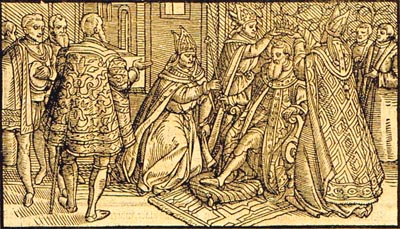Macbeth and its sources
The history of Macbeth that Shakespeare read in his main source, Holinshed, was rather commonplace tale of rivalries and the exchange of power through legitimate and hard-fought battle.
The sinister intensity of private murder and secret ambition is Shakespeare's addition; the general effect of his changes is to make the character of Macbeth darker.
Though not technically a source, Shakespeare seems to have been influenced by the newly arrived monarch: the play in the text we have of it* stresses the interests of--and possibly flatters--James I, who wrote on witches, and was of Scottish descent.
- What was the original story?
- Can a tyrant and murderer be a tragic hero?*
- More about the illustration.*
Footnotes
-
The director's cut?
Macbeth is the shortest of Shakespeare's plays; there has been some suggestion that some scenes may have been omitted, others (notably those involving Hecate) added. Click for more on problems in the texts of the plays.
-
More than one way to play a tragedy
There are several ways of looking at the tragic in Shakespeare and in Shakespeare's time: the medieval (which Richard II refers to), the classical (which Hamlet refers to), or that of the native dramatic tradition (which Falstaff refers to).
-
Makbeth vsurpeth the crowne
The illustration is accompanied by this narrative:
At length therefore communicating his purposed intent with his trustie frendes, amongst whom Banquho was the chiefest, vpon confidence of theyr promised ayde, he slewe the kind at Ennernes . . . Then hauing a companie about him of such as he had made priuie to his enterpryce, he caused himselfe to be proclaymed kind, and foorthwith went vnto Scone, where by common consent, he receyued the inuesture of the kingdome according to the accustomed maner.
